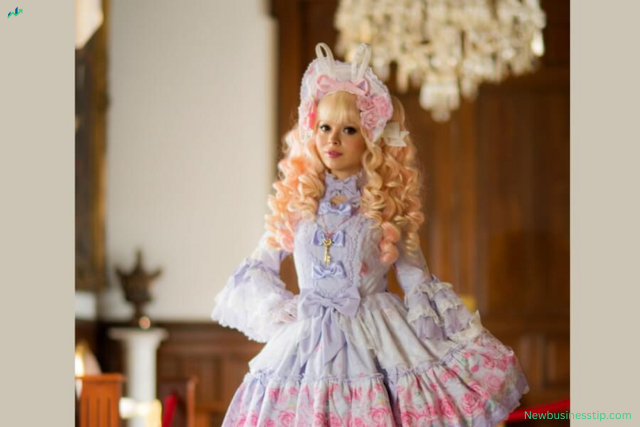Lolita design is a one of a kind and unmistakable style established in Japan, yet with worldwide impact and allure. It stands apart for its lavish, Victorian-propelled clothing, frequently highlighting chime molded or A-line skirts, underskirts, hoods, and a demeanor of class. Something other than dress, Lolita design addresses a social development. This article will take you through its portrayal, history, motivation, and social effect, furnishing the two novices and fans with a profound comprehension of this spellbinding style.
Description
At the core of Lolita style is the volume of the skirt, which is accomplished using slips or crinolines. The skirts are commonly either chime formed or A-line, mirroring the notable outline of the style. The outfits habitually include:
- Blouses: Often featuring long or short sleeves, worn under a jumper dress or with a skirt.
- Dresses: Knee-length, paired with blouses or standalone pieces such as JSKs (jumperskirts) or OPs (one-pieces).
- Wigs and Headwear: Worn with frill like hair retires from, which bring out a Victorian-enlivened beguile.
- Socks and Shoes: Knee socks, lower leg socks, or leggings are normal, with level shoes or high heels embellished with bows.
- Undergarments: Victorian-style drawers or shorts worn under slips to keep up with unobtrusiveness and genuineness.
Lolita style encapsulates unobtrusiveness, tastefulness, and a feeling of departure from present day, quick style.
History
The starting points of Lolita design follow back to the 1970s in Japan, rising up out of a mix of Japanese road style and an interest with Western Victorian and Extravagant dress. The style started to get forward momentum in the Harajuku area of Tokyo, becoming related with defiant youth culture. Throughout the long term, Lolita style has developed into particular substyles, for example,
- Classic Lolita: More quelled, with rare roused prints and a complex tasteful.
- Sweet Lolita: The most perky and juvenile, frequently highlighting pastel tones, ornamentations, and charming themes.
- Gothic Lolita: Hazier and more secretive, consolidating dark ribbon, crosses, and a Victorian-Gothic allure.
Sources of Inspiration
Lolita fashion draws from several historical and cultural sources, including:
- Victorian and Rococo Eras: The emphasis on petticoats, corsets, and opulent fabrics originates from these periods.
- Western Literature and Film: Novels such as Alice in Wonderland and The Secret Garden have inspired motifs and themes within Lolita fashion.
- Japanese Pop Culture: The charming, doll-like tasteful of anime and manga impacts the unconventional components of Lolita style, especially in the Sweet Lolita substyle.
Popularization
By the 1990s, Lolita style had earned worldwide respect. Brands, for example, Child, The Stars Radiate brilliantly and Celestial Pretty assumed a key part in extending the style past Japan. Web-based entertainment, online discussions, and shows additionally filled its notoriety across Europe, North America, and different pieces of Asia.
Key moments in Lolita fashion’s rise include:
- The opening of Lolita fashion stores abroad.
- Lolita communities and events in cities like Paris, New York, and Tokyo.
- Lolita meetups, where fans gather to showcase their outfits and discuss the latest trends.
Table: Popular Lolita Fashion Brands
| Brand Name | Year Established | Style Focus |
| Baby, The Stars Shine Bright | 1988 | Sweet Lolita |
| Angelic Pretty | 1979 | Sweet Lolita |
| Moi-même-Moitié | 1999 | Gothic Lolita |
| Innocent World | 1999 | Classic Lolita |
Motives
The thought processes behind wearing Lolita design are changed, with numerous devotees considering it to be something other than a dress decision. Key motives include:
- Self-expression: Lolita style permits people to grandstand their imagination and uniqueness in a universe of efficiently manufactured design.
- Rebellion: As far as some might be concerned, Lolita is a type of dissent against cultural assumptions, especially around gentility and customary excellence guidelines.
- Escapism: Wearing Lolita can move people into a dreamland, one loaded up with eccentricity, style, and sentimentality for previous periods.
Socioeconomic Dimension
While Lolita design is a work of art, it likewise accompanies a sticker price. Top notch Lolita articles of clothing are frequently costly, as they are made with perplexing textures, ribbon, and craftsmanship. Lolitas might contribute hundreds, even thousands, of dollars into their closets, making it a subculture that, at times, requires a huge monetary responsibility.
In any case, the local area likewise embraces Do-It-Yourself culture, where aficionados make their own pieces or change existing ones to suit the Lolita stylish. This has made the style more open to a more extensive crowd.
Sociocultural Dimension
The Lolita people group is an affectionate, worldwide organization of people who share an enthusiasm for the style. It has its own language, customs, and standards. A few vital components of the local area include:
- Online Forums and Groups: Stages like LiveJournal, Reddit, and Facebook bunches where Lolitas talk about design tips, coordinate meetups, and share outfit motivation.
- Meetups and Tea Parties: Coordinated occasions where Lolitas can wear their best outfits and associate with similar people.
- Rules of Etiquette: Lolita style disciples frequently adhere to unwritten guidelines of humility, pleasantness, and regard, particularly during public occasions.
Terminology

Here are a few normal terms utilized inside the Lolita design local area:
- JSK (Jumperskirt): A sleeveless dress worn over a shirt.
- OP (One-piece): A dress with sleeves, ordinarily worn without a pullover.
- Petticoat: A voluminous underskirt that gives the Lolita outline its shape.
- Lolita: Alludes to both the design and the person who wears it.
Substyles of Lolita Fashion
- Sweet Lolita: Pastel tones, bows, and adorable themes.
- Gothic Lolita: Dim tones, trim, and Victorian impacts.
- Classic Lolita: Muffled colors, flower prints, and one of a kind style.
- Punk Lolita: A mix of troublemaker design with Lolita feel.
Gallery
Visual representation is key in Lolita fashion. The utilization of lovely prints, textures, and mind boggling specifying makes it quite possibly of the most outwardly shocking style in the design world.
- Images of Lolita fashion dresses and outfits (Include images in the gallery section with proper alt text for SEO optimization).
See Also
- Harajuku Fashion: Another influential Japanese street fashion.
- Kawaii Culture: The culture of cuteness in Japan that overlaps with Lolita fashion.
References:
Citations
Include reputable sources such as fashion books, articles, and academic papers that delve into Lolita fashion, its origins, and cultural significance.
General References
Provide additional resources like fashion history blogs, official Lolita brand websites, and online fashion communities.
Further Reading and Documentaries
For those interested in learning more about Lolita fashion, consider the following:
- Books such as “Kamikaze Girls“, which feature Lolita characters.
- Documentaries like “Lolita: The Complex Beauty of Japanese Fashion”.
Ending Remark
Lolita design is something other than a style — it’s a dynamic articulation of history, culture, and individual innovativeness. As you investigate this exquisite and eccentric world, you’ll find not exclusively its rich legacy yet in addition the energy and commitment of its worldwide local area. Whether you’re drawn to its Victorian roots, its modern reinterpretations, or the unique way it allows for personal expression, Lolita fashion continues to captivate and inspire. Embrace the charm, explore the details, and let your own Lolita journey unfold.

